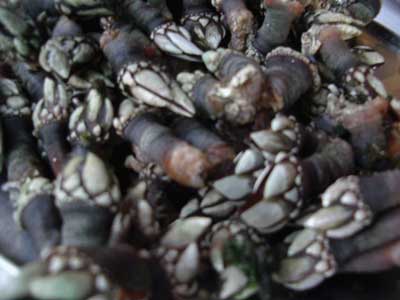Like most things from the sea around Spain, barnacles (Pollicipes cornucopiae) are eaten here. They are found solely on Northern Spain 's Atlantic coasts, principally in Galicia and to a much lesser extent along the Cantabrian strip, and eaten, moderately, throughout the country. See also Galican food

After spawning, the larvae grow to a ‘commercial' size within six months (at least five centimetres long 0.9cm wide). They are collected by perceberos (percebeiros in Galician), surely one of the most dangerous jobs in Europe. Their collection is regulated by several regional boards governing when and how they can be picked.
 Perceberos by Asturian artist Mariano Moré (1899-1975) Perceberos by Asturian artist Mariano Moré (1899-1975)
Spanish barnacle buffs distinguish two types: the highly prized “de sol”, which grow on sunny and wave-beaten rocks and which are distinguished by their short, fat peduncle (foot); and the less prized “de sombra” or “aguarones” (shaders or grippers), which spend more time below water and have a slenderer and longer body and a higher water content. Demand is high and many of the barnacles in Spain and even in Galicia here are actually shipped in from Portugal, Morocco and Canada, which have no tradition of consuming them. This leads to astonomical prices being charged at certain times of the year. The Spanish tradition appears to relatively new, dating back to the 18th century.
Click on play to watch video about barnacles collectors- You need flash enabled to see this.
The Galician barnacle industry has for a number of years been concerned about falling productivity levels. This has worsened since the Prestige oil spill (November 2002) decimated much of its rocky coastline. The extreme difficulty in studying their biology in situ due to the hazardous environment they live in means there is a paucity of biological studies which provide solutions to their low productivity.

They are prepared always fresh by boiling them in salty (or better still salt) water for five minutes or as the Gallegos say “auga a ferver, percebes botar, auga a ferver percebes sacar”. In Galicia they are eaten hot and the Basque Country cold. In parts of Galicia they are served with potatoes (cachelos) cooked in the same water as the barnacles.
Tienes cara de percebe means you're a bit of a dork.
Note: the Castilian Capitán Haddock does not exclaim ‘blistering barnacles' (the meaningless percebes ampollantes) but rather ‘rayos y truenos' – thunder and lightning (the binome lightning and thunder literally, like blanco y negro, is the other way around in Spanish)
See also
see Fish in Spain
|

 Perceberos by Asturian artist Mariano Moré (1899-1975)
Perceberos by Asturian artist Mariano Moré (1899-1975) 